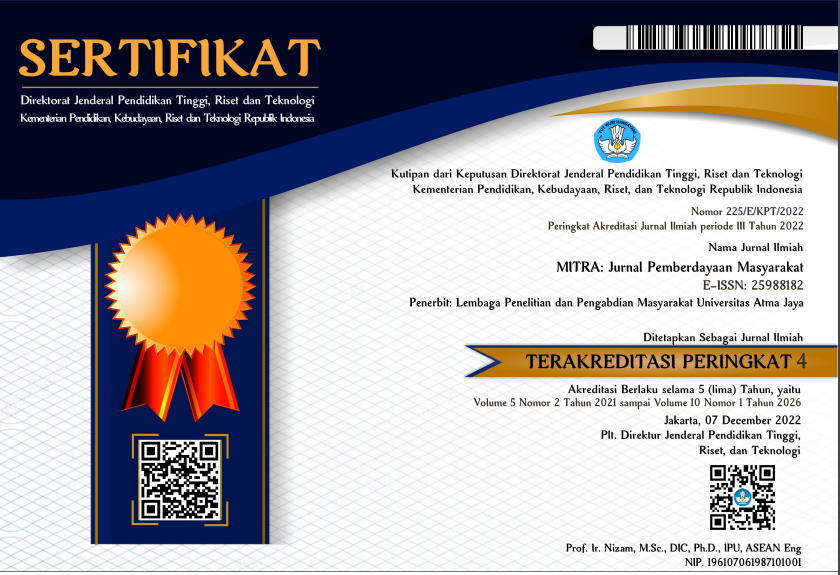Socialization of Tempeh as Organic and Healthy Food for Household Mother in The South Tangerang City
DOI:
https://doi.org/10.25170/mitra.v2i2.103Kata Kunci:
household mother, soybean, yeast, healthy food, tempehAbstrak
Tempeh is a traditional Indonesian food that has many advantages as food and the process of making it is quite simple. However, the community knowledge about tempeh and the skills to produce healthy tempeh are still low. This community service aimed to increase the knowledge about tempeh and to improve the skills of its manufacturers in making healthy and good quality tempeh. The activities were carried out for mothers living in Villa Dago Tol complex, Ciputat, South Tangerang 15414, by using the methods of counseling, demonstration, and mentoring. Monitoring was conducted to measure the success rate of participants in producing healthy tempeh. The level of community knowledge about tempeh was evaluated through survey method. The results of counseling, demonstration, and mentoring succeeded in improving the participant skills as seen from the participants' success in following the healthy tempeh-making procedure. The results were also reinforced by the results of monitoring where all participants managed to create healthy tempeh. Survey results showed participants’ increasing knowledge of healthy tempeh and motivation in producing healthy tempeh. Assessment of participants showed good results, especially in improving knowledge (73% stated strongly agree and the rest agree). The ability of the facilitators in delivering the material was also considered good by the participants (92% stated strongly agree and the rest agree). As a follow-up, the participants suggested that the training be extended to the other communities and the training also include a variety of topics such as the manufacturing of tofu, healthy food processing, sewing, and many others.
Referensi
A'yun, Q., Suwanto, A., Barus, T. (2015). Genetic profiles of escherichia coli isolated from Indonesian tempeh based on Enterobacterial Repetitive Intergenic Consensus-Polymerase Chain Reaction (ERIC-PCR). J. Microbiol. Indonesia, 9 (2), 58--64. http://dx.doi.org/10.5454/mi.9.2.2.
Astuti, M. (1999). Iron availability of tempe and uses in iron deficiency anemia. Di dalam Agranoff J, Sutrisno N editor. The complete handbook of tempe: The unique fermented soybean of Indonesia. Singapore: The American Soybean Association.
Barus, T., Suwanto, A., Wahyudi, A. T., & Wijaya, H. (2008). Role of bacteria in tempe bitter taste formation: microbiological and molecular biological analysis based on 16S rRNA gene. Microbiol Indones., 2(1), 17--21.
Barus, T, Griselda, H.N., Suwanto, A., Tan, A.W. (2010). Metagenomic analysis of bacterial diversity in tempe using terminal restriction fragmen length polymorphism (TRFLP) technique. Biota. 15, 273--80.
Esaki, H. H., Onozaki, S., Kawakishi, & Osawa, T. (1996). New antioxidant isolation from Tempe. J Agric Food Chem., 44, 696--700.
Gunawan, A. W., Soka, S., & Hartanti, A. T. (2014). Biologi dan bioteknologi cendawan dalam praktik. Jakarta (ID): Penerbit Universitas Atma Jaya.
Hartanti, A. T., Rahayu, G., Hidayat, I. (2015). Rhizopus species from fresh tempeh collected from several regions in Indonesia. Hayati J Biosci., 22, 136--142.
Hermana, M. M., & Karyadi, D. (1999). Composition and nutritional value of tempe, its uses in the improvement of the nutritional value of food. In Agranoff J. (Ed.) The complete handbook of tempe: The unique fermented soyfood of Indonesia. Singapore: The American Soybean Association.
Hong, K., J, Lee, C., H., Kim, S., W. (2004). Aspergillus oryzae GB-107 fermentation improves nutritional quality of food soybeans and feed soybean meals. J Med Food, 7(4), 430--435.
Karyadi, D. & Lukito, W. (1996). Beneficial effects of tempeh in disease prevention and treatment. Nutr Rev, 54(11), 94--98.
Keuth, S. & Bisping, B. (1994). Vitamin B12 production by Citrobacter freundii or Klebsiella pneumoniae during tempeh fermentation and proof of enterotoxin absence by PCR. J Appl Environ Microbiol., 60, 1495--1499.
Kiriakidis, S., Hogemeier, O., Starcke, S., Dombrowski, F., Hahne, J. C., Pepper, M., Jha, H. C., & Wernert, N. (2005).
Novel tempeh (fermented soyabean) isoflavones inhibit in vivo angiogenesis in the chicken chorioallantoic membrane assay. Br J Nutr., 93(3), 317--323.
Sporleder, et al. (2002). Process for the production of nutritional products with microorganisms using sequential solid substrate and liquid fermentation. US: United States Patent.
Sudigbia, I. (1999). Tempe in the management of infant diarrhea in Indonesia. Di dalam: Agranoff J, Sutrisno N editor. The complete handbook of tempe: The unique fermented soybean of Indonesia. Singapore: The American Soybean Association.
Zheng, R. Y., Chen, G. Q., Huang, H., Liu, X. Y. (2007). A monograph of Rhizopus. Sydowia, 59(2), 273--372.
Unduhan
Diterbitkan
Cara Mengutip
Terbitan
Bagian
Lisensi
This license allows reusers to distribute, remix, adapt, and build upon the material in any medium or format for noncommercial purposes only, and only so long as attribution is given to the creator. If you remix, adapt, or build upon the material, you must license the modified material under identical terms.







_.jpeg)




.png)
2.png)
.png)
.png)



